A chronology of events in 1940.
January 1940
February 1940
March 1940
18 March – Benito Mussolini meets Hitler near the Brenner Pass. Hitler used this meeting to strike at Mussolini’s ego and convince him to join the war. He motioned to Mussolini that if he wants Italy to be a second rate power in the Mediterranean, then forget about going to war. But if he wants to bring his nation to glory, then join Germany in the defeat of France and England. This was too much for Mussolini to hear. He accepts Hitler’s offer to join the war only if Germany’s attack on France is successful. He again motions to Hitler that Italy is not prepared to join a war that may last three to four years. Hitler accepts Mussolini’s offer, knowing the burden of fighting another front is gone.
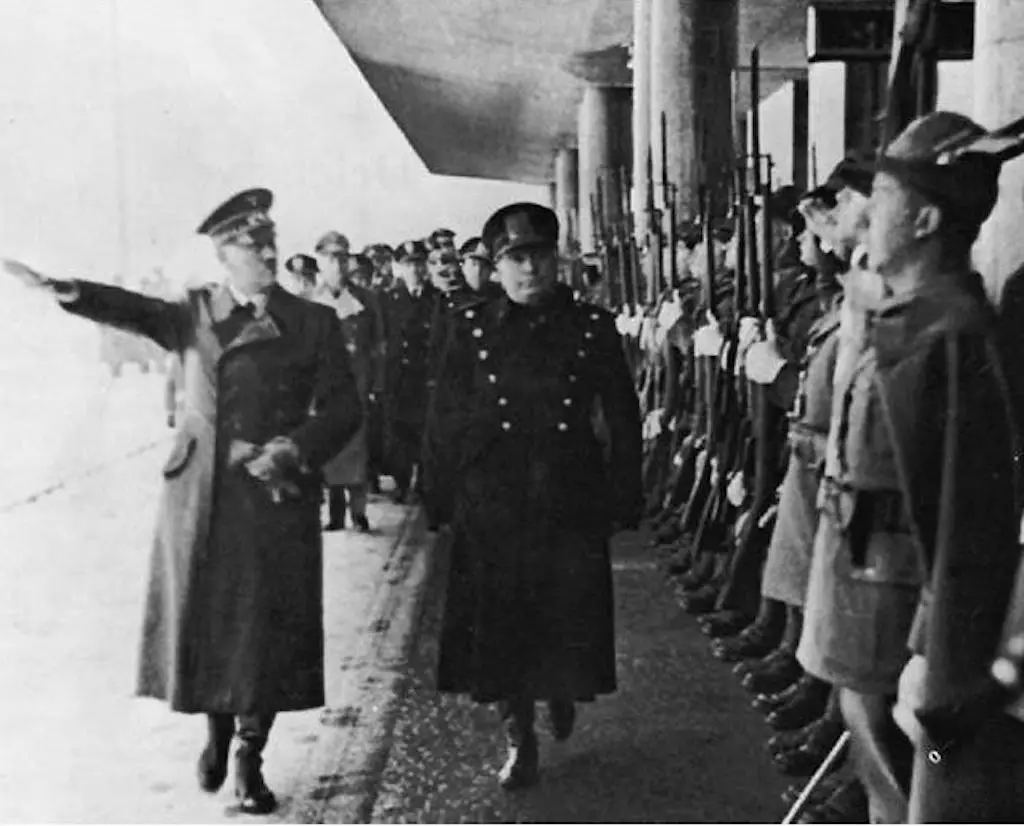
Hitler and Mussolini meet at the Brenner Pass on 18 March 1940.
April 1940
09 April – Mussolini received word from the German ambassador that Germany had invaded Norway and Denmark. Although Mussolini welcomes the news, he is resentful in being kept in the dark. Nevertheless, he gives a speech applauding the German triumphs.
May 1940
France
10 May – German troops conquer Belgium and Holland en route to France. Mussolini realizes that the time was coming for him to act as he promised in support of Germany and the Pact of Steel.
June 1940
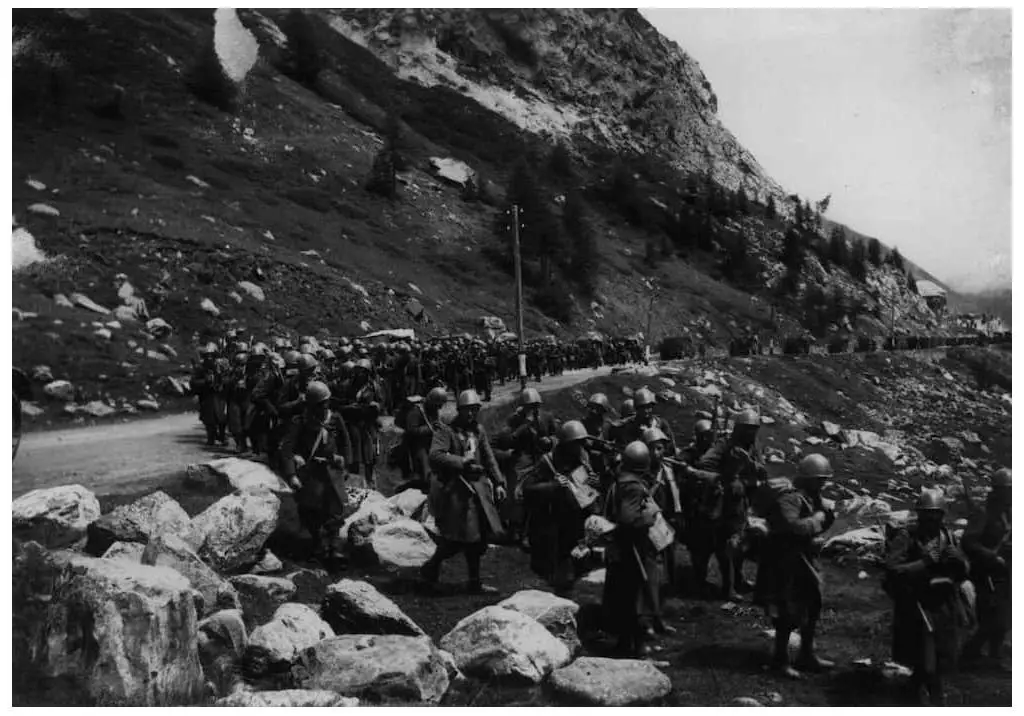
Italian troops marching through the Little St. Bernard Pass on the French border in June 1940. Image: Archivio Centrale dello Stato.
June – Italy declares war on France and England. Mussolini saw France’s imminent surrender and decided to reap some of the spoils of France. In order to do this, he needed to absorb as much French land as possible. Mussolini had an interest in obtaining Nice, Corsica, French Somaliland, and Tunisia. Italy masses 32 divisions on the French border and commences an attack. These divisions are severely under-equipped with outdated artillery and not enough pots and pans to feed their troops. The Italians launch their initial attack through the Little Saint Bernard Pass in the Alps but stop due to a massive snowstorm. Another assault continues through the French Riviera towards Nice, but that too is stopped in Menton, only five miles inside France. By this time France is ready for an armistice with Germany.
See also: Life in Italy During World War II
12 June – Italian Submarine Bagnolini sinks British Light Cruiser Calypso in the Mediterranean.
13 June – Italian destroyer Strale sinks British submarine HMS Odin off Taranto.
14 June – French naval forces bombard Genoa and Vado.
16 June – Italian destroyers sink British submarine HMS Grampus.
Eritrea
23 June –Italian submarine Torricelli sinks British destroyer HMS Khartoum off Eritrea.
France
24 June – France falls to Germany. Mussolini insists France must also surrender to Italy or the fighting will continue. Hitler and France oblige. This is a fruitless victory, and the only thing Mussolini truly receives is the knowledge that Germany can win wars without Italy’s assistance. Although the Italian Esercito made little progress in the two-week war with France, the Regia Aeronautica was very productive. The Regia Aeronautica conducts 715 bomber sorties, drops 276 tons of bombs, and flies 1,337 fighter sorties in 14 days.
Mediterranean
28 June –Australian cruiser HMAS Sydney sinks Italian destroyer Espero off Bengasi.
July 1940
04 July – The start of a series of first moves by Italy that led to humiliating defeats of the British. Lt. Gen Guglielmo Nasi struck westward from Ethiopia into Sudan. They capture several border towns and arrive within 300 miles of Khartoum. Within 6 weeks, Nasi conquered British Somaliland, causing the British to evacuate from the Sea at Berbera.

Map of the Italian invasion of British Somaliland. Image: Aotearoa.
05 July – British bombers sink Italian destroyer Zeffiro near Tobruk.
08 July – Reggia Aeronautica bombers bomb the British cruiser HMS Gloucester. Scoring a direct hit and killing her captain and 17 crewmen. Gloucester survives, but with crippled steering gear.
09 July – Battle of Punto Stilo ends indecisively. British battleship HMS Warspite damages Italian battleship Giulio Cesare.
11 July –Italian submarine smg. Marconi sinks British destroyer HMS Escort off Gibraltar.
Aegean Sea
19 July -Italian light cruisers Giovanni delle Bande Nere and Bartolomeo Colleoni cruising near Crete give fight to four British destroyers. After two hours of naval engagement, HMS Sydney and destroyer Havock appear off the horizon. The Italian ships realize they are outnumbered 3-1 and decide to outrun them, but a shell from the Sydney hits the Colleoni, leaving her dead in the water. Within minutes the Colleoni is hit by a torpedo and sinks. As the British attempt to save the Italian sailors, Italian bombers appear and begin bombing the British warships, forcing them to abandon the rescue. Hundreds of Italian sailors die. This omen proved that the Italian Navy is blind due to the lack of radar and that the Italian navy had no coordination with the air force.
Mediterranean
20 July– British bombers sink Italian destroyers Nembo and Ostro off Tobruk.
Africa
Africa seemed to be a good starting point for Italian expansion. On paper, Italy had an impressive force; Approximately 172,000 troops forming 14 Divisions and separated into the 5th Army in the west and 10th Army to the east. Initial estimates in strength showed Italian troops in Libya alone would overwhelm the British in Egypt by looking at the table below. However, on a strategic level, Italy only had a 6:1 ratio of Artillery to infantry battalions. The British had 8:1. The British possessed seventy-five 25 pdrs to an Italian division which had twenty-four 75mm and twelve 100mm guns. The 1,500 guns the Italians possessed were old and their tanks were obsolete, even weaker than the British Bren-gun carriers. The most notable of the British forces in the region under Wavell’s command, the 7th Armored Division (Desert Rats) had 300 armored cars, light and cruiser tanks and Bren gun carriers.
 Italian Italian |  Commonwealth Commonwealth | |
|---|---|---|
| Troops | 208,000 (36,000 Libyan Nationals | 50,000 (86,000 in Middle East Area) |
| Guns | 1,500 | 150 |
| Tanks | 300 | 45 |
| Fighter Planes | 450 | 205 |
| Bombers | 140 | 140 |
The Italian situation in Ethiopia was very similar. Italy had 280,000 troops available with almost 400 aircraft. Of these troops, approximately 200,000 were native Africans and approximately 80,000 were Italian. The British, on the other hand, had only 19,000 troops in British Somaliland, Kenya and Sudan. Although some British troops are colonials. The general Italian military force in Africa consists of 70% African troops. These troops fight well in hand to hand combat, but according to many Italian officers, tend to “panic” when under fire.
August 1940
01 August – Italian destroyer Ugolino Vivaldi sinks British submarine HMS Oswald off Cape Spartivento.
19 August – British Somaliland surrenders to Italy.
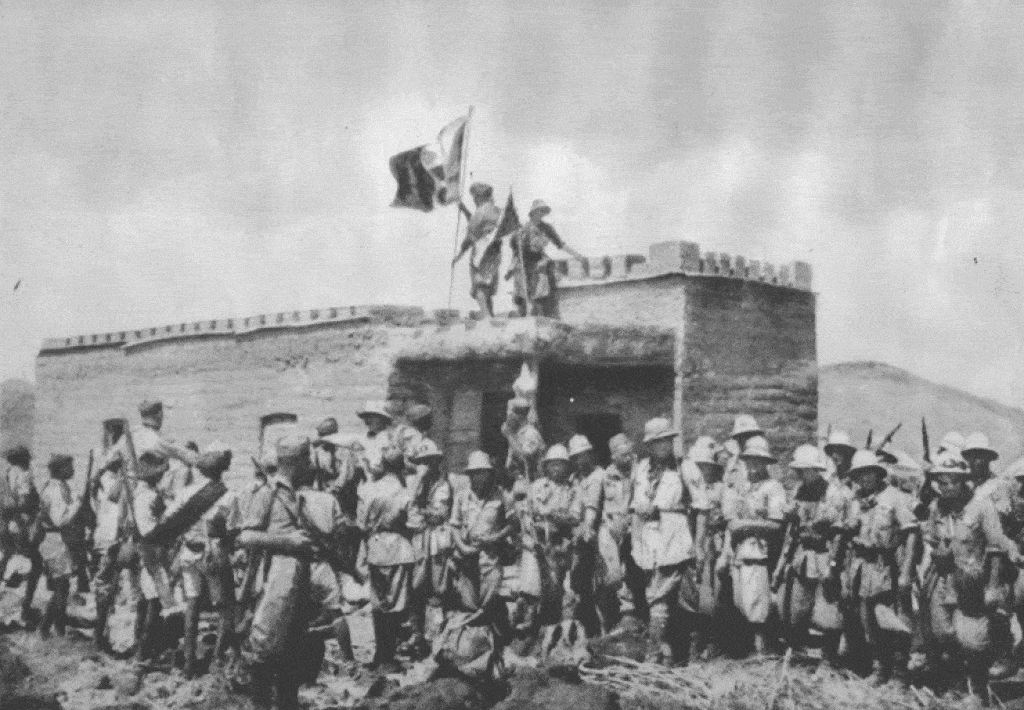
Italian infantry in front of a captured British outpost Girreh in British Somaliland.
September 1940
13 September – The attack on British forces in Egypt is to coincide with Operation Sealion (the invasion of England by Germany). After Mussolini realizes Sealion is postponed indefinitely, he orders Marshal Rodolfo Graziani to launch his 10th army, made of a total of seven divisions, into combat across the Egyptian border.
British tanks and armored cars made bold attacks into Libya, forcing the Italians to transfer troops from the 5th Army to the 10th and acquiring 2,500 motor vehicles and gaining the delivery of 70 M-11 medium tanks from Italy. The British retreated to buy time and reinforcements. After four days and 60 miles inside Egypt, Graziani stops his attack due to supply logistics. Graziani was now 80 miles west of the British defenses in Mersa Matruh. To go any farther, Graziani said, would risk being defeated until supplies were available.
Mussolini angered over the sudden stop of the 10th Army, urges Graziani to continue 300 miles into the port of Alexandria. Graziani is appalled. Eventually, Field Marshal Pietro Badoglio promises 1,000 tanks to Graziani. This promise is never kept. The recent military operations in Ethiopia and Spain drained Italy of many needed supplies and equipment. Graziani is forced to change his attack plan and cannot penetrate deeper than Sidi Barrani.
Mediterranean
September 16 – British bombers sink Italian destroyers Aquilone and Borea off Bengasi.
September 22 –British submarine HMS Osiris sinks Italian torpedo boat Palestro off the coast of Albania.
Germany, Italy and Japan
27 September – Tripartite alliance formed between Germany, Italy, and Japan.
October 1940
Mediterranean
12 October – British cruisers sink Italian destroyer Artigliere and torpedo boats Airone and Ariel off Tunisia.
Eritrea
21 October– British bombers sink Italian destroyer Francesco Nullo off Eritrea.
Kenya
24 October – Italian aircraft bomb Malindi.
Britain
25 October – Hardly ever discussed was Italy’s involvement in the Battle of Britain. Against Hitler’s wishes and most Italian military leaders, Mussolini sent some 200 aircraft including 73 Fiat BR.20 Cicogna (Stork) medium bombers into occupied Belgium to conduct Italy’s share of bombing England. See OOB.
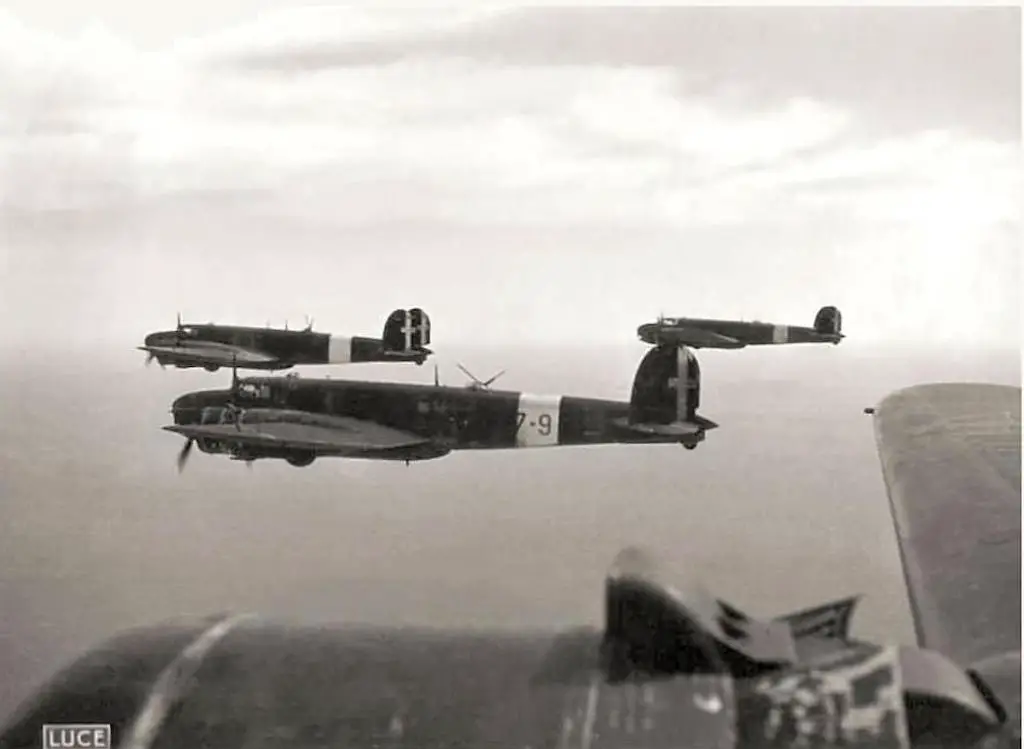
Fiat Br.20 Cicogna bombers in flight.
Little success is achieved in this campaign due to the poor performance of Italian aircraft against the British and the edge England has with the use of radar. Italian sorties had to be conducted at night or a few daylight raids limited to 1,500 lb bombs per aircraft. Within four months, the Italian supply of BR.20 Storks is cut by 25% due to British interceptions. A total of 54 tons of ordnance is dropped on England. The fighter “gruppi” completed 883 sorties, losing nine aircraft in combat.
Greece
28 October – Italian troops cross the Albanian-Greek border with only two weeks of preparation. Italian Generals are outraged at Mussolini’s hasty plan. Mussolini decided to take Greece due to Germany’s entry into Romania. Additionally, approximately 60,000 weathered Italian troops had been pulled out of Albania to assist in the fall harvest in Italy. The majority of Italians who conducted this invasion are recruits. General Visconti-Prasca uses seven divisions of the 9th and 11th Armies to initiate the attack. To make matters worse, Mussolini never authorized the use of the Navy or the Air Force to assist in this attack. This invasion coincided with the Greek rainy season when the weather dropped below freezing and many Italian soldiers did not possess winter boots.

Esercito Italiano riding an L3/35 tankette on the Albanian/Greek border.
From the onset, it is apparent that the Greeks intend to fight. The Italians advance in a four-pronged attack up to 25 miles into Greek territory. In every turn, there seems to be an ambush or a destroyed bridge. The Greeks then attack three divisions strong and push the Italians back. With the assistance of England, who pledged support for Greece, the Royal Air Force pound Italian installations in Greece and Albania. The Italians retreat back into Albania. One-third of Albania is now under Greek control.
November 1940
Sudan
06 November – The British mount their counteroffensive in the Sudan town of Gallabat. Approximately 7,000 troops under the command of Sir William Slim storm Gallabat with tanks and infantry. Without air cover, he is unable to immediately achieve his goals of capturing Gallabat and Metemma. The Italian Air Force shoots down seven gladiators with the loss of five and bombs his troops. The relentless bombings force Commonwealth soldiers to temporarily withdraw. Commonwealth casualties include 52 dead and 125 wounded before Italian forces abandon Gallabat.
Italy
11 November – Battle of Taranto. The H.M.S. Illustrious conducts a bombing of the Italian base in Taranto which damages three battleships and cripples Italy’s chance of securing the Mediterranean. Italian battleship Conte Di Cavour sinks in shallow water and is put out of action for the remainder of the war.
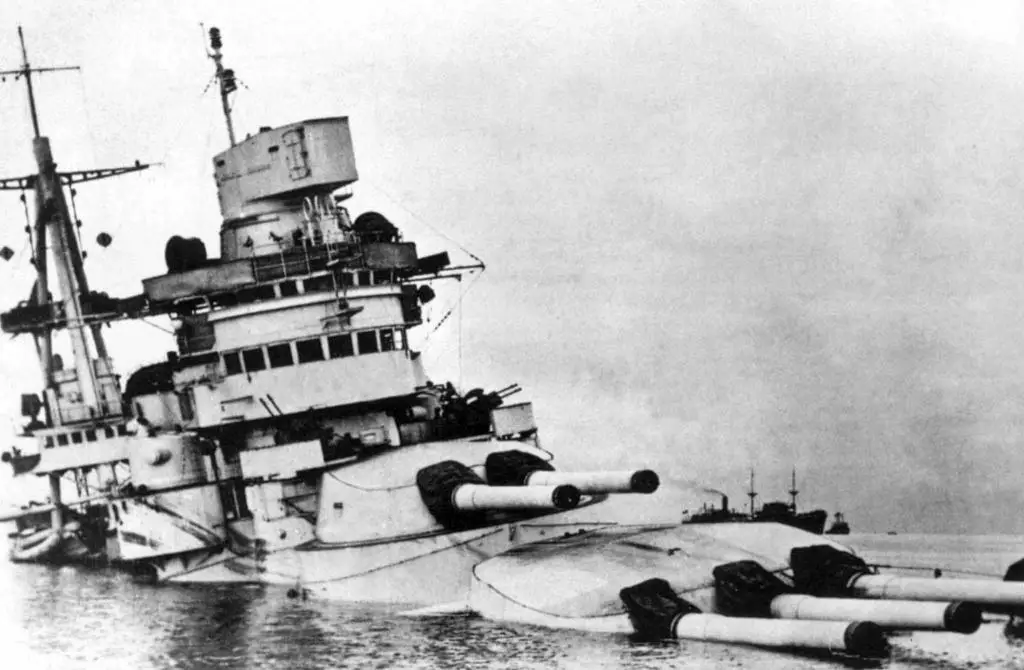
The Conte di Cavour sinks in shallow water.
Mediterranean
20 November – Italian torpedo boat Confienza is rammed by a merchant vessel it is escorting and sinks in the Adriatic.
27 November – Battle of Cape Teulada (Cape Spartivento) ends indecisively.
December 1940
Greece
04 December – Mussolini instructs Dino Alfieri to fly to Berlin and request German assistance in the invasion of Greece. Hitler sees no choice but to assist Italy. The military’s confidence in Mussolini is now beginning to disappear due to his hasty and ignorant orders.
Mediterranean
05 December – Italian torpedo boat Calipso sinks after hitting a mine near Tripoli.
Egypt
09 December – Marshal Graziani debates whether to continue his attack into Egypt or wait for supplies. He decided to deploy his infantry divisions into strong points facing east and south at Sidi Barrani. He then requested some motorized transport to assist in furthering the invasion, but Mussolini rejected this request for the planned invasion of Yugoslavia. Wavell’s British forces receive reinforcements including 31,000 motorized troops, 120 guns and 275 tanks (50 of which were Matilda’s and 100 Cruisers), 60 armored cars and 150 aircraft. Among them are the Hurricanes which outclass all Italian fighters in the region).
Wavell consolidates his forces under General Richard O’Connor. Under General O’Connor, the British attack Sidi Barrani. The Italians are caught completely off guard. The Italians fight hard as they try to organize their forces. General Pietro Maletti, still in pajamas, is killed while firing his machine gun at the British. This attack yields 2,000 Italian prisoners.
Nebeiwa
Italian artillerymen encounter the British Matilda’s for the first time and fought against them with great bravery, but with little success. An English combatant at the scene described the battle:
“The Italian and Libyan dead were everywhere. The guns were piled around with empty cases where men had fired to the very last. The Italians…fought like hell in Nebiewa.”
16 December – The British begin winning battle after battle, Italian tanks are no match to the British Matilda’s and British naval bombardments. The Italians realized that if their artillery cannot defeat the Matilda’s, then neither can the infantry. However, the Italian Maletti Group manage to use their 37 and 47/32 mm guns to destroy 35 of the 57 Matilda’s in an engagement. The Tummar posts destroyed another 14 Matilda’s. Additionally, the remaining Matilda’s are destroyed in Bardia and Tobruk. However, Italian forces under Graziani are quickly losing battles and do not possess the transport for an effective strategic withdrawal. Within two weeks of combat, the Italians are forced back 200 miles to Tobruk and lose 115,000 Italian and African colonials who surrender or are captured by February of 1941.
18 December – Italian torpedo boats sink British submarine HMS Triton in the Adriatic.
Greece
17 December – British bombers attack the Italian naval base in Rhodes, Greece.
Albania
Mid-December – The Italians finally halt the Greek advance into Albania. However, they do not have enough supplies to mount a counteroffensive until the German reinforcements come in.
08 December – British naval forces bomb the Albanian port of Valona.
Mediterranean
23 December – Italian torpedo boat Fratelli Cairoli sinks after hitting a mine off the coast of Tripoli.
29 December – Italian torpedo boat Antares sinks Greek submarine Proteus off the coast of Albania.
